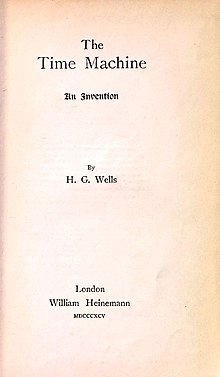
Back آلة الزمن (رواية) Arabic Zaman maşını (roman) Azerbaijani Машината на времето Bulgarian দ্য টাইম মেশিন Bengali/Bangla Vremenski stroj BS La màquina del temps (novel·la) Catalan Stroj času (román) Czech Y Peiriant Amser Welsh Tidsmaskinen Danish Die Zeitmaschine German
 Title page | |
| Author | H. G. Wells |
|---|---|
| Cover artist | Ben Hardy |
| Language | English |
| Genre | Science fiction |
| Publisher | William Heinemann (UK) Henry Holt (US) |
Publication date | 1895 |
| Publication place | United Kingdom |
| Pages | 84 |
| Text | The Time Machine at Wikisource |
The Time Machine is an 1895 dystopian post-apocalyptic science fiction novella by H. G. Wells about a Victorian scientist known as the Time Traveller who travels to the year 802,701. The work is generally credited with the popularization of the concept of time travel by using a vehicle or device to travel purposely and selectively forward or backward through time. The term "time machine", coined by Wells, is now almost universally used to refer to such a vehicle or device.[1]
Utilizing a frame story set in then-present Victorian England, Wells' text focuses on a recount of the otherwise anonymous Time Traveller's journey into the far future. A work of future history and speculative evolution, The Time Machine is interpreted in modern times as a commentary on the increasing inequality and class divisions of Wells' era, which he projects as giving rise to two separate human species: the fair, childlike Eloi, and the savage, simian Morlocks, distant descendants of the contemporary upper and lower classes respectively.[2][3] It is believed that Wells' depiction of the Eloi as a race living in plenitude and abandon was inspired by the utopic romance novel News from Nowhere (1890), though Wells' universe in the novel is notably more savage and brutal.[4]
In his 1931 preface to the book, Wells wrote that The Time Machine seemed "a very undergraduate performance to its now mature writer, as he looks over it once more", though he states that "the writer feels no remorse for this youthful effort". However, critics have praised the novella's handling of its thematic concerns, with Marina Warner writing that the book was the most significant contribution to understanding fragments of desire[clarify] before Sigmund Freud's The Interpretation of Dreams, with the novel "[conveying] how close he felt to the melancholy seeker after a door that he once opened on to a luminous vision and could never find again".[5]
The Time Machine has been adapted into two feature films of the same name, as well as two television versions and many comic book adaptations. It has also indirectly inspired many more works of fiction in many media productions.
- ^ Pilkington, Ace G. (2017). Science Fiction and Futurism: Their Terms and Ideas. McFarland. p. 137.
- ^ Naish, Darren (2018). "Speculative Zoology, a Discussion". Scientific American Blog Network. Archived from the original on 18 July 2019. Retrieved 16 August 2019.
- ^ "Class in The Time Machine". The British Library. Archived from the original on 15 July 2021. Retrieved 1 July 2021.
- ^ Parrinder, Patrick (2000), "Science Fiction: Metaphor, Myth or Prophecy?", Science Fiction, Critical Frontiers, London: Palgrave Macmillan UK, pp. 23–34, doi:10.1007/978-1-349-62832-2_2, ISBN 978-1-349-62834-6, archived from the original on 20 March 2022, retrieved 1 July 2021
- ^ Wells, Herbert George (2007). The Time Machine. London: Penguin UK. pp. 94–96. ISBN 9780141439976.